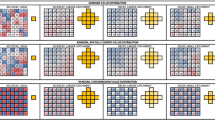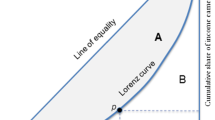Abstract
The paper introduces a spatial decomposition of the Gini coefficient that supports the detection of spatial autocorrelation conjointly with an indicator of overall inequality. An additive pairwise decomposition based on a spatial weights matrix partitions inequality between observations that are geographically neighbors and those that are not. A framework for inference on the spatial decomposition is also suggested. The statistical properties of the decomposition measure are evaluated in a Monte Carlo simulation and an empirical illustration involving per capita income inequality in the US states is also provided.





Similar content being viewed by others
Notes
A referee noted that the Gini Coefficient can also be consistent with multiple Lorenz curves and can thus suffer from a different form of an identification problem.
Briant et al. (2010) use the term spatial Gini in reference to the application of a Gini index for a variable (income, productivity) measured on spatial units.
Related work developing joint measures of inequality and concentration is reported in Arbia and Piras (2009).
The original form of this statistic was first implemented in the package STARS: Space-Time Analysis of Regional Systems (Rey and Janikas 2006), but until this paper has not been formally described.
The 95 % confidence interval for the rejection frequencies under the null (\(\rho =0.05\)) is based on the distribution under the null: \(z = \frac{\hat{\alpha } - \alpha }{\sqrt{(\alpha (1-\alpha ))/(M+1)}} \). With \(\alpha =0.05\) and \(M=999\) this yields and interval of \([0.0383, 0.0617]\).
References
Allison, P.: Measures of inequality. Am. Sociol. Rev. 43, 865–880 (1978)
Arbia, G.: The role of spatial effects in the empirical analysis of regional concentration. J. Geogr. Syst. 3, 271–281 (2001)
Arbia, G., Piras, G.: A new class of spatial concentration measures. Comput. Stat. Data Anal. 53, 4471–4481 (2009)
Bickenbach, F., Bode, E.: Disproportionality measures of concentration, specialization and localization. Int. Reg. Sci. Rev. 31, 359–388 (2008)
Briant, A., Combes, P., Lafourcade, M.: Dots to boxes: Do the size and shape of spatial units jeopardize economic geography estimations? J. Urban Econ. 67(3), 287–302 (2010)
Clark, S., Hemming, R., Ulph, D.: On indices for the measurement of poverty. Econ. J. 91(362), 515–526 (1981)
Dawkins, C.: Measuring the spatial pattern of residential segregation. Urban Stud. 41(4), 833 (2004)
Dawkins, C.: The spatial pattern of black–white segregation in us metropolitan areas: an exploratory analysis. Urban Stud. 43(11), 1943 (2006)
Dawkins, C.: Space and the measurement of income segregation. J. Reg. Sci. 47(2), 255–272 (2007)
Duncan, O., Duncan, B.: A methodological analysis of segregation indexes. Am. Sociol. Rev. 20(2), 210–217 (1955)
Friedman, M., Friedman, R.: Capitalism and freedom. University of Chicago press, Chicago (2002)
Grannis, R.: Discussion: segregation indices and their functional inputs. Sociol. Methodol. 32(1), 69–84 (2002)
Grannis, R.: T-communities: Pedestrian street networks and residential segregation in Chicago, Los Angeles, and New York. City Community 4(3), 295–321 (2005)
James, D.R., Tauber, K.: Measures of segregation. Sociol. Methodol. 15, 1–32 (1985)
Kain, J.F.: Housing segregation, negro employment, and metropolitan decentralization. Q. J. Econ. 82(2), 175–197 (1968)
Kanbur, R.: The policy significance of inequality decompositions. J. Econ. Inequal. 4(3), 367–374 (2006)
Krugman, P.: Geography and trade. The MIT Press, Cambridge (1991)
Ladd, H.: Spatially targeted economic development strategies: do they work? Cityscape 1(1), 193–218 (1994)
Levine, D.: Gilding the ghetto. Across Board 36(9), 10 (1999)
Massey, D., Denton, N.: The dimensions of residential segregation. Soc. Forces 67, 281 (1988a)
Massey, D. and Denton, N.: Suburbanization and segregation in US metropolitan areas. Am. J. Sociol. 592–626 (1988b)
Massey, D., White, M., Phua, V.: The dimensions of segregation revisited. Sociol. Methods Res. 25(2), 172 (1996)
Morgan, B.: A distance-decay based interaction index to measure residential segregation. Area 211–217 (1983)
Morrill, R.: On the measure of geographical segregation. In: Geography Research Forum, vol. 11, pp. 25–36 (1991)
Quigley, J.: New directions for urban policy. Hous. Policy Debate 5(1), 97–106 (1994)
Reardon, S.F., Firebaugh, G.: Measures of multigroup segregation. In: Stolzenberg, R.M. (ed.) Sociological Methodology, pp. 33–67. Blackwell, Boston (2002)
Reardon, S.F., O’Sullivan, D.: Measures of spatial segregation. Sociol. Methodol. 34, 121–162 (2004)
Rey, S.J.: Spatial analysis of regional income inequality. In: Goodchild, M., Janelle, D. (eds.) Spatially Integrated Social Science: Examples in Best Practice, pp. 280–299. Oxford University Press, Oxford (2004)
Rey, S.J., Dev, B.: \(\sigma \)-convergence in the presence of spatial effects. Papers Reg. Sci. 85(2), 217–234 (2006)
Rey, S.J., Janikas, M.V.: STARS: space-time analysis of regional systems. Geogr. Anal. 38(1), 67–86 (2006)
Schelling, T.: Models of segregation. Am. Econ. Rev. 59(2), 488–493 (1969)
Shorrocks, A., Wan, G.: Spatial decomposition of inequality. J. Econ. Geogr. 5(1), 59 (2005)
Silber, J.: Factor components, population subgroups and the computation of the Gini index of inequality. Rev. Econ. Stat. 71, 107–115 (1989)
Sokal, R.R., Oden, N.L., Thomson, B.A., Kim, J.: Testing for regional differences in means: distinguishing inherent from spurious spatial autocorrelation by restricted randomization. Geogr. Anal. 25, 199–210 (1993)
White, M.: The measurement of spatial segregation. Am. J. Sociol. 88, 1008–1018 (1983)
Wilson, W.: The Truly Disadvantaged: The Inner City, The Underclass and Urban Policy. University of Chicago Press, Chicago (1987)
Wong, D.: Spatial decomposition of segregation indices: a framework toward measuring segregation at multiple levels. Geogr. Anal. 35(3), 179–194 (2003a)
Wong, D.S.: Implementing measures of spatial segregation in GIS. Comput. Environ. Urban Syst. 27, 53–70 (2003b)
Wong, D.W.S.: Spatial indices of segregation. Urban Stud. 30(3), 559–572 (1993)
Author information
Authors and Affiliations
Corresponding author
Additional information
This research was funded in part by NSF Award OCI-1047916, SI2-SSI: CyberGIS Software Integration for Sustained Geospatial Innovation.
Rights and permissions
About this article
Cite this article
Rey, S.J., Smith, R.J. A spatial decomposition of the Gini coefficient. Lett Spat Resour Sci 6, 55–70 (2013). https://doi.org/10.1007/s12076-012-0086-z
Received:
Accepted:
Published:
Issue Date:
DOI: https://doi.org/10.1007/s12076-012-0086-z




